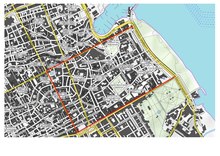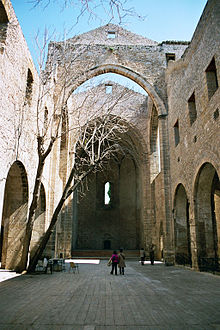La Kalsa
La Kalsa or Tribunali is a historic district in the city center of Palermo . It is bordered to the west by Via Maqueda, to the south by Via Lincoln and the Villa Giulia Park, to the east by the sea by the Foro Italico and to the north by Via Vittorio Emanuele and the port of La Cala. South of La Kalsa is the Corso-dei-Mille / Sant'Erasmo district. For a long time, La Kalsa, with its little winding streets, was the stronghold of the Cosa Nostra .
Naming
The name La Kalsa comes from the Arabic , from the word Al-Khalesa (الخالصة), which means "the chosen one". The Italian name Mandamento Tribunali comes from the fact that the Inquisition Court was located in the Palazzo Chiaramonte-Steri .
history
In ancient times, large parts of La Kalsa were still below sea level. Hamilkar and Hannibal landed here in 480 BC. BC with their Carthaginian fleet when they prepared an attack on the Greek city of Himera . The walls of the Punic city , occupied by Phoenicians and Carthaginians, once extended to the confluence of the Papyrus and Kemonia rivers near the current intersection of Via Roma and Via Vittorio Emanuele.
Al-Khalesa was built in the 9th century and was one of the first planned Arab settlements in Europe. It was the administrative center of the city of Bal'harm (Palermo), which was under Arab rule until it was conquered by the Normans in 1072 . In the 970s, Palermo expanded into a major Muslim city comparable to Cairo or Córdoba . Around 937 the Arabs moved their base from Al-Kasr (now Cassaro or Castle District) to Al-Khalesa and built a fortified palace near the port. Al-Khalesa not only housed the emir and his court, but also contained the arsenal and prison, hammam baths, a mosque and government offices. There were no shops or markets in the area. Al-Khalesa was surrounded by a stone wall with four gates, the most famous of which was the Bab al-Bahr or Marine Gate towards the port. The center of Al-Khalesa was near what is now Piazza Kalsa. Much of the square's current “arabesque” architecture, such as the Greek gate, is the product of Spanish Moorish revival movements from the 16th century and cannot be directly traced back to the emirate of Bal'harm. The district still has narrow and winding streets, as was the case in the 11th century.
After the Normans conquered Palermo, they preferred to move their headquarters to a higher level, in the Cassaro. The Kalsa remained an Arab quarter with markets and mosques.
The Kalsa district was heavily bombed by the Americans during World War II and then abandoned for decades. It attracted impoverished squatters, many of whom lived in disastrous sanitary conditions in the bombed-out ruins. The Sicilian-American writer Dodici Azpadu describes it as an “Arab ghetto”. The area has since been revitalized and is home to art galleries, restored churches and palaces, and other tourist attractions. Today, after the many armed street attacks have fallen sharply, La Kalsa is the nightlife district of Palermo and in the summer months the Kals'art cultural festival is celebrated there. In traditional restaurants like the Antica Focacceria San Francesco, boiled veal spleen is served with flatbread made from chickpea flour (Pane di Milza) and arancini, just like 180 years ago.
La Kalsa and the Mafia
The La Kalsa district bordering the harbor, previously run down to the “ Bronx level” due to its high crime rate , has remained in a dilapidated state since the Second World War and has in some cases only been used as an illegal rubbish dump. Many small local businesses and handicrafts such as tinkerers or scissors grinders went about their noisy business in the kalsa. The quarter has only recently been renovated, it now looks bright and clean and, with its picturesque alleys, is a popular destination for tourist groups. For many years, La Kalsa was considered the city's poor house. The melting pot of La Kalsa, which suffered from depopulation with simultaneous squatting and building speculation after the bombing of 1943 (even 40 years after the end of the Second World War, the rubble in the old town of Palermo had not been completely removed) , has since been deep and high in poverty Unemployment shaped, so that the Mafia found an ideal breeding ground here and temporarily had its "main battlefield" here. The La Kalsa harbor district is closely linked to the Santa Maria di Gesú mafia family, one of the oldest and strongest clans in Sicily , led by Stefano Bontade and Salvatore “Totuccio” Contorno , and who were able to establish their rule here. It was then Ottavio Abbate who sold drugs to addicts in La Kalsa.
On the other hand, the kalsa was also known for its anti-mafia hunters. These included the brothers Borsellino Giovanni Falcone , who grew up in a middle-class family in Piazza Magione .
Attractions
Some of the attractions of La Kalsa include:
- Churches
- Chiesa di San Francesco
- Chiesa della Martorana
- Basilica La Magione
- Lo Spasimo
- Chiesa di San Cataldo
- La Gancia
- Chiesa di San Giovanni dei Napoletani
- Chiesa della Santissima Pietà
- Chiesa di Santa Teresa
- City gates
- Porta Felice
- Palaces
- Palazzo Abatellis
- Palazzo Butera
- Palazzo Chiaramonte-Steri
- Palazzo Mirto
- Palazzetto Mirto
- Palazzo di Sant'Elia (già "Palazzo del Marchese Santa Croce")
- Palazzo Trabucco della Torretta
- Hotel Patria (near Palazzo Naselli d'Aragona)
- theatre
- Santa Cecilia Theater
- Garibaldi Theater
- Bellini Theater
- Montevergini Theater
- Places
- Piazza Marina
- Piazza della Magione
- Piazza Kalsa
- Fountain
- Fontana del Genio
- Fontana Pretoria
- Oratorios
- Oratorio dei Bianchi
- Oratorio di San Lorenzo
- other sights
- Museo delle marionette
- Passeggiata delle Cattive
- Via Roma (Palermo)
- Chiesa di Santa Maria dello Spasimo
List of known people from La Kalsa
- Dodici Azpadu
- Paolo Borsellino (1940–1992), Italian judge
- Giovanni Falcone (1939–1992), Italian lawyer
literature
- Giovanna Cassata, Evelina De Castro, Maria Maddalena De Luca (eds.): Il quartiere della Kalsa a Palermo: Dalle architetture civili e religious delle origini alle attuali articolate realtà museali. Regione Sicilia, Palermo 2013, ISBN 978-88-6164-222-5 .
Notes individual evidence
- ↑ mandamento Tribunali. In: palermoweb.com. Retrieved April 1, 2020 (Italian).
- ↑ Mafia. Italy's shame. The daily mirror. May 14, 2010
- ↑ To Palermo, where markets are theaters. Chaos, garbage, mafia: the capital of Sicily had a bad reputation for a long time. Now the Palermitans are taking back their city. And we are proud that it is the Italian city of culture this year. Tagblatt. 2nd July 2018
- ↑ Alone without the Mafia. The time. February 3, 2000
- ↑ La Kalsa, the old town of Palermo, has not become chic, but it is worth living in. The New Zurich Times. 23 September 2017
- ↑ Palermo Capital of Culture - Manifesta & Mafia, how does it work? November 1, 2011
- ↑ "We are fed up with being slaughter cattle", SPIEGEL editor Birgit Kraatz on the power of the Mafia in Palermo. The mirror. September 23, 1985
- ^ Geographical Palermo. Information on La Kalsa. Marco Polo travel guide
- ↑ La Kalsa on Lonely Planet Sicily
- ↑ Ana Lilia Pérez: Cocaine Seas: The ways of the worldwide drug trade. Pantheon Publishing House. 2016 ISBN 978-3-641-18419-3 .
- ↑ Arresti, condanne e scarcerazioni La Kalsa fortino degli Abbate. Live Sicilia.it
- ↑ The Borsellino case





